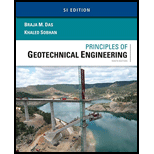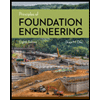
Find the passive force
Answer to Problem 14.1P
The passive force
Explanation of Solution
Given information:
The height (H) of the retaining wall is 6.0 m.
The soil friction angle
The unit weight
The equation for the angle of wall friction
Calculation:
Determine the angle of wall friction
Substitute
Calculate passive force
Here,
Refer Figure (14.4) “Variation of
Take the passive earth pressure coefficient for the soil having friction angle of
Substitute 9.0 for
Thus, the passive force
Want to see more full solutions like this?
Chapter 14 Solutions
Principles Of Geotechnical Engineering, Si Edition
- 12.2 ), Figure P12.2, and the following values to determine the at-rest lat- eral earth force per unit length of the wall. Also find the location of the resultant. H = 5 m, H1 = 2 m, H, = 3 m, y = 15.5 kN/m², yt = 18.5 kN/m², 4' = 34°, c' = 0, q = 20 kN/m², . Repeat problem when water level Groundwater at ground surface. Figure P12.2arrow_forwardA frictionless retaining wall is shown ih the figure below. q= 10 kN/m 1= 15 kN/m o = 26° d'=8 kN/m 4 marrow_forward6. Details of a retaining wall are shown in the figure below. The unit weight of the wall material is 23 kN/m³. Assume a reduction factor K = 2/3 to consider the cohesion and friction angle at the base slab. Check the stability of the wall in terms of overturning and sliding failure. Use Rankine's theory to compute the active earth pressure. Soil 2 Y2 = 17 kN/m³ 6.5 m Im 2 m <-1.5m - Yc = 23 kN/m³ c₂ = 10 kN/m² 92 = 25° a = 15⁰ Soil 1 Y₁ = 16 kN/m³ c₁ = 0 kN/m² P₁ = 30°arrow_forward
- Q: For the retaining wall shown in the following figure, determine the force per unit length of the wall for Rankine's active state. Also find the location of the resultant. 3 m z 3 m y = 16 kN/m³ ' = 30° c' = 0 Groundwater table Y sat = 18 kN/m³ ' = 35° c' = 0arrow_forward3) A retaining wall is illustrated IN THE Figure. Determine the Rankine active force, (Pa) per unit length of the wall and the location of the resultant. H = 9 m, H1 = 4 m, Υ1 = 16.5 kN/m3, Υ2 = 20.2 kN/m3, ø'1 = 30, ø'2 = 34, q= 21 kN/m2arrow_forward6. Details of a retaining wall are shown in the figure below. The unit weight of the wall 2/3 to consider the cohesion and material is 23 kN/m³. Assume a reduction factor K friction angle at the base slab. Check the stability of the wall in terms of overturning and sliding failure. Use Rankine's theory to compute the active earth pressure. 6.5 m m Ye= 23 kN/m³3 4 m -1.5m Soil 2 Y2 = 17 kN/m³ c₂ = 10 kN/m² 42 = 25° a = 15° Soil 1 Y₁ = 16 kN/m³ c₁ = 0 kN/m² 4₁ = 30°arrow_forward
- A 6m retaining wall is supporting a soil with the following properties:Unit weight = 16 KN/cu.mAngle of internal friction = 25ºCohesion = 14 Kpaa. Assuming no tensile cracks occurs in the soil; determine its normal pressure acting at the back of the wall.b. If tensile crack occurs in the soil, calculate its active pressure acting on the wall.c. Find the location of tensile crack measured from the surface of horizontal backfill.arrow_forward13.2 Assume that the retaining wall shown in Figure 13.9 is frictionless. Determine the Rankine active force per unit length of the wall, the variation of active earth pressure with depth, and the location of the resultant. If H = 4m, Ø = 36° and y = 18 kN/m3 kN Ans. P, = 37.44", z = 1.33m m 13.3 Assume that the retaining wall shown in Figure 13.9 is frictionless. Determine the Rankine passive force per unit length of the wall, the variation of lateral earth pressure with depth, and the location of the resultant. If H = 5m, Ø = 35° and y = 14 kN/m? Ans. Pp 645.8 kN z = 1.67m m. Sand Unit weight = y (or density = p) %3D H c' = 0 8' (angle of wall friction) = 0 Figure 13.9arrow_forwardA retaining wall 6 m high with a vertical back face has c'- ϕ' soil for backfill. For the backfill, γ = 18.1 kN/m^3, c' = 29 kN/m^2, and ϕ' = 18˚. Taking the existence of the tensile crack into consideration, a. determine the active force, Pa, per unit length of the wall for Rankine’s active state. b. determine the passive force, Pp, per unit length for Rankine's passive state.arrow_forward
- .A 6 m vertical retaining wall is supporting a horizontal backfill of a normally consolidated soil having a unit weight of 18 kN/m3 and a friction angle of 35 degrees. Cohesion of soil is zero. (Use four decimal places) A. Determine the at rest force per unit length of the wall. B. Determine the active force develop at the wall. C. Calculate the passive force acting on the wall.arrow_forwardConsider a 4-m-high retaining wall with a vertical back and horizontal granular backfill, as shown in Figure 12.25. Given: γ = 18 kN/m3, Φ' = 40º, c' = 0, ẟ' = 20º, kv = 0, and kh = 0.2. Determine the passive force Ppe per unit length of the wall taking the earthquake effect into consideration.arrow_forward11.7 A retaining wall is shown in Figure 11.22. Determine the Rankine active force, Pa, per unit length of the wall and the location of the resultant for each of the following cases: a. H = 12 ft, H, = 4 ft, y, = 105 lb/ft, y= b. H = 20 ft, H, = 6 ft, y, = 110 lb/ft, y = 126 lb/ft', oi = 34°, d; = 34°, q = 300 lb/ft 122 Ib/ft', i = 30°, = 30°, q = 0 6 Cengage Learning. All Riphts Reserved. May not be copied, scanned, or duplicated, in whole or in part Due to elsctronic rights, some third party content may be suppressed from the eBook and/or eChapter(s). s deemed that any suppressed content does nol maierially affect the overall learning exnerience Ceneaec ernin neerves the right to mrmove additional.contantarrow_forward
 Principles of Geotechnical Engineering (MindTap C...Civil EngineeringISBN:9781305970939Author:Braja M. Das, Khaled SobhanPublisher:Cengage Learning
Principles of Geotechnical Engineering (MindTap C...Civil EngineeringISBN:9781305970939Author:Braja M. Das, Khaled SobhanPublisher:Cengage Learning Principles of Foundation Engineering (MindTap Cou...Civil EngineeringISBN:9781305081550Author:Braja M. DasPublisher:Cengage Learning
Principles of Foundation Engineering (MindTap Cou...Civil EngineeringISBN:9781305081550Author:Braja M. DasPublisher:Cengage Learning

